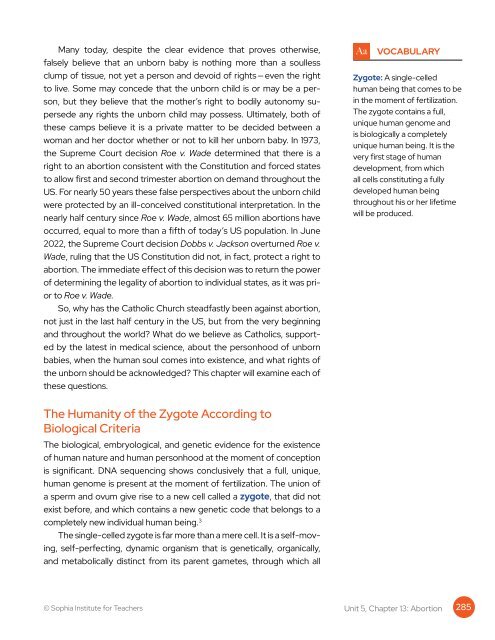CMW-WB-CH13
Create successful ePaper yourself
Turn your PDF publications into a flip-book with our unique Google optimized e-Paper software.
Many today, despite the clear evidence that proves otherwise,<br />
falsely believe that an unborn baby is nothing more than a soulless<br />
clump of tissue, not yet a person and devoid of rights — even the right<br />
to live. Some may concede that the unborn child is or may be a person,<br />
but they believe that the mother’s right to bodily autonomy supersede<br />
any rights the unborn child may possess. Ultimately, both of<br />
these camps believe it is a private matter to be decided between a<br />
woman and her doctor whether or not to kill her unborn baby. In 1973,<br />
the Supreme Court decision Roe v. Wade determined that there is a<br />
right to an abortion consistent with the Constitution and forced states<br />
to allow first and second trimester abortion on demand throughout the<br />
US. For nearly 50 years these false perspectives about the unborn child<br />
were protected by an ill-conceived constitutional interpretation. In the<br />
nearly half century since Roe v. Wade, almost 65 million abortions have<br />
occurred, equal to more than a fifth of today’s US population. In June<br />
2022, the Supreme Court decision Dobbs v. Jackson overturned Roe v.<br />
Wade, ruling that the US Constitution did not, in fact, protect a right to<br />
abortion. The immediate effect of this decision was to return the power<br />
of determining the legality of abortion to individual states, as it was prior<br />
to Roe v. Wade.<br />
So, why has the Catholic Church steadfastly been against abortion,<br />
not just in the last half century in the US, but from the very beginning<br />
and throughout the world? What do we believe as Catholics, supported<br />
by the latest in medical science, about the personhood of unborn<br />
babies, when the human soul comes into existence, and what rights of<br />
the unborn should be acknowledged? This chapter will examine each of<br />
these questions.<br />
Aa<br />
VOCABULARY<br />
Zygote: A single-celled<br />
human being that comes to be<br />
in the moment of fertilization.<br />
The zygote contains a full,<br />
unique human genome and<br />
is biologically a completely<br />
unique human being. It is the<br />
very first stage of human<br />
development, from which<br />
all cells constituting a fully<br />
developed human being<br />
throughout his or her lifetime<br />
will be produced.<br />
The Humanity of the Zygote According to<br />
Biological Criteria<br />
The biological, embryological, and genetic evidence for the existence<br />
of human nature and human personhood at the moment of conception<br />
is significant. DNA sequencing shows conclusively that a full, unique,<br />
human genome is present at the moment of fertilization. The union of<br />
a sperm and ovum give rise to a new cell called a zygote, that did not<br />
exist before, and which contains a new genetic code that belongs to a<br />
completely new individual human being. 3<br />
The single-celled zygote is far more than a mere cell. It is a self-moving,<br />
self-perfecting, dynamic organism that is genetically, organically,<br />
and metabolically distinct from its parent gametes, through which all<br />
© Sophia Institute for Teachers Unit 5, Chapter 13: Abortion<br />
285


